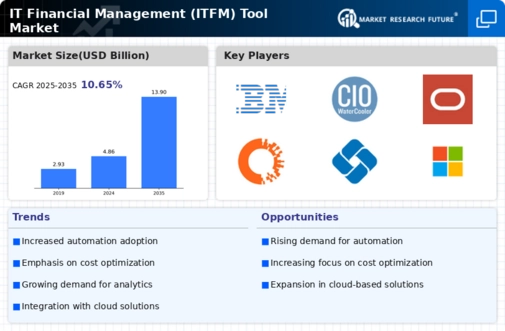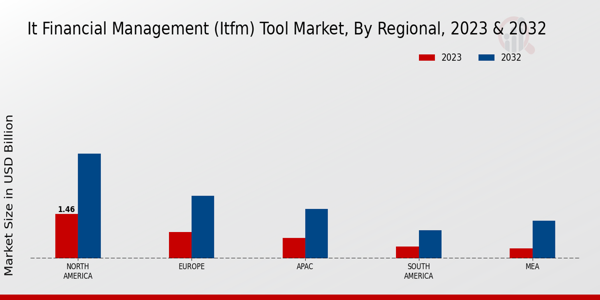Market Growth Projections
The Global IT Financial Management (ITFM) Tool Market Industry is projected to experience substantial growth in the coming years. With a market value of 4.86 USD Billion in 2024, it is anticipated to reach 13.9 USD Billion by 2035, reflecting a compound annual growth rate (CAGR) of 9.99% from 2025 to 2035. This growth is driven by various factors, including the increasing demand for cost optimization, integration with cloud services, and the focus on data-driven decision making. As organizations continue to prioritize effective financial management, the ITFM market is poised for significant expansion.
Integration with Cloud Services
The integration of IT Financial Management (ITFM) tools with cloud services is a notable driver in the Global IT Financial Management (ITFM) Tool Market Industry. As organizations migrate to cloud-based infrastructures, the need for tools that can effectively manage and optimize cloud spending becomes paramount. ITFM solutions that offer seamless integration with cloud platforms enable businesses to gain insights into their cloud expenditures, ensuring better financial control. This trend is expected to contribute to the market's growth, as companies increasingly prioritize cloud cost management in their financial strategies.
Focus on Data-Driven Decision Making
The emphasis on data-driven decision making is reshaping the Global IT Financial Management (ITFM) Tool Market Industry. Organizations are increasingly recognizing the value of data analytics in financial planning and management. ITFM tools equipped with advanced analytics capabilities enable businesses to derive actionable insights from financial data, facilitating informed decision making. This trend is expected to gain momentum as companies strive to enhance their financial performance through data-driven strategies. The ability to analyze financial metrics and forecast future trends positions ITFM tools as essential components in modern financial management.
Regulatory Compliance and Governance
Regulatory compliance and governance requirements are significant drivers for the Global IT Financial Management (ITFM) Tool Market Industry. Organizations are compelled to adhere to various financial regulations, necessitating robust financial management practices. ITFM tools assist businesses in maintaining compliance by providing comprehensive reporting capabilities and audit trails. As regulatory frameworks evolve, the demand for ITFM solutions that can adapt to these changes is likely to increase. This focus on compliance not only mitigates risks but also enhances the overall financial governance of organizations, further propelling the adoption of ITFM tools.
Increasing Demand for Cost Optimization
The Global IT Financial Management (ITFM) Tool Market Industry experiences a growing demand for cost optimization solutions. Organizations are increasingly seeking ways to streamline their IT expenditures and improve financial visibility. In 2024, the market is projected to reach 4.86 USD Billion, reflecting a significant shift towards more efficient financial management practices. Companies are leveraging ITFM tools to analyze spending patterns, identify cost-saving opportunities, and enhance budget forecasting. This trend is likely to continue as businesses recognize the importance of aligning IT investments with overall financial goals, thereby driving the adoption of ITFM solutions.
Rising Adoption of Automation Technologies
The rising adoption of automation technologies is a key driver in the Global IT Financial Management (ITFM) Tool Market Industry. Organizations are increasingly implementing automation to streamline financial processes, reduce manual errors, and enhance operational efficiency. ITFM tools that incorporate automation features allow businesses to automate budgeting, forecasting, and reporting tasks, freeing up valuable resources for strategic initiatives. As automation becomes more prevalent, the demand for ITFM solutions that offer these capabilities is likely to grow. This trend aligns with the broader movement towards digital transformation in financial management.























